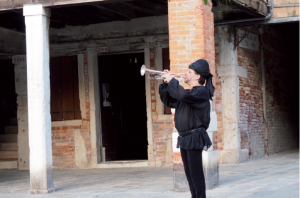CULTURE “The Merchant of Venice Still Speaks to Us”
 The first performance of the Merchant of Venice in the Jewish Ghetto of Venice is a reckoning with an imaginary figure that has been haunting the place for centuries, overshadowing its real inhabitants while gaining enormous fame worldwide and becoming a proverbial name. To commemorate two historic anniversaries, the 500th anniversary of the formation of the Jewish Ghetto in Venice and the 400th anniversary of William Shakespeare’s death, Compagnia de’ Colombari and Ca’ Foscari University of Venice have joined forces to offer the world an imaginative, ambitious production. A performance directed by Karin Coonrod, with an international cast, that brings the Merchant to life in a way almost impossible anywhere else, investigating its poignant and painful exploration of love and hate, justice, and, above all, what it means to be human. The event, part of the official program of the Ghetto Quincentennial, will take place on 26 July – 1 August 2016, and is here introduced by Shaul Bassi, Project Director.
The first performance of the Merchant of Venice in the Jewish Ghetto of Venice is a reckoning with an imaginary figure that has been haunting the place for centuries, overshadowing its real inhabitants while gaining enormous fame worldwide and becoming a proverbial name. To commemorate two historic anniversaries, the 500th anniversary of the formation of the Jewish Ghetto in Venice and the 400th anniversary of William Shakespeare’s death, Compagnia de’ Colombari and Ca’ Foscari University of Venice have joined forces to offer the world an imaginative, ambitious production. A performance directed by Karin Coonrod, with an international cast, that brings the Merchant to life in a way almost impossible anywhere else, investigating its poignant and painful exploration of love and hate, justice, and, above all, what it means to be human. The event, part of the official program of the Ghetto Quincentennial, will take place on 26 July – 1 August 2016, and is here introduced by Shaul Bassi, Project Director.
By Shaul Bassi*
Great Renaissance intellectuals such as Leon Modena, Sara Copio Sullam, Simone Luzzatto; influential political and economic figures such as Gracia Nasi and Daniel Rodriga; ordinary people with picturesque nicknames such as Achille Silva ‘Gambeta’ or Sarina Parombolo; Lina Levi, 7 years old, and Bruno Perlmutter, 9 years old, among the youngest deportees from Venice. No list would ever do justice to the multiplicity of Jewish lives of the Ghetto, and it is a irony of history that the genius of Shakespeare has made Shylock the most famous Venetian Jew of all times.
The first performance of the Merchant of Venice in the Ghetto is our reckoning with an imaginary figure that has been haunting this place for centuries, overshadowing its real inhabitants while gaining enormous fame worldwide and becoming a proverbial name. To stage this controversial and inflammatory play in the year of the Ghetto quincentenary is a challenge that we could accept only upon special conditions: having an intellectual laboratory such as Ca’ Foscari, where the project was conceived and where the various themes of the play could be analyzed and debated by a community of international scholars and students (culminating in an intensive ‘Shylock Project’ summer school at Fondazione Cini); inviting a exceptional theatre company such as Compagnia de’Colombari that would create the play on site, not importing a ready made production from elsewhere but bringing the artistic vision of Karin Coonrod and an international and multiethnic cast of extraordinarily talented actors. The two partners, in close dialogue with the Jewish community and with the invaluable support of numerous individuals and institutions, have been committed to honoring the heritage of the Ghetto and the people who have called this place home. By taking upon ourselves the artistic, organizational and ethical responsibility of this project, we agreed we did not want a philologically or politically correct version aiming at neutralizing the troubling issues of the play; we did not want to make Shylock a sympathetic character to redeem the potential antisemitism of the play. The result of this fortunate collaboration is here and now for you.
The Merchant of Venice still speaks to us.
It is about the history and persistence of antisemitism; it is about the roles imposed on us by society and economic status; it is about the struggle for pluralism and acceptance of ethnic and religious difference; it is about the struggle between individual will and collective obligation; it is about love, friendship, and conflicts between women and men, young and old. It is, in this unique occasion, about the Ghetto of Venice, not as a poignant and evocative places of the past, but as meeting point of people and a vibrant hub of art, spirituality and culture now and for years to come.
*Shaul Bassi is a professor at the Ca’ Foscari University of Venice. This text was published in the booklet “The Merchant in Venice”, by Ca’ Foscari University of Venice, Compagnia de’ Colombari and with the support of the Venice Ghetto 500 Committee. The picture portrays the musician and composer Frank London in the Ghetto
